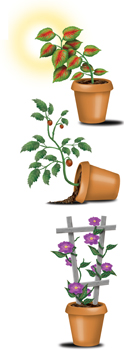Tropisms and Rapid Movements
 What are some examples of environmental stimuli to which plants respond?
What are some examples of environmental stimuli to which plants respond?
Like all living things, plants need the power of movement to cope with the environment. Many plant movements are slow, but some are so fast that even animals cannot keep up with them.
Tropisms Plant sensors that detect environmental stimuli signal elongating organs to reorient their growth. These growth responses are called tropisms.  Plants respond to environmental stimuli such as light, gravity, and touch.
Plants respond to environmental stimuli such as light, gravity, and touch.
BUILD Vocabulary
WORD ORIGINS The word tropism comes from a Greek word that means “turning.”

FIGURE 24–17 Three Tropisms
▸ Light The tendency of a plant to grow toward a light source is called phototropism. This response can be so quick that young seedlings reorient themselves in a matter of hours. Recall that changes in auxin concentration are responsible for phototropism. Experiments have shown that auxins migrate toward shaded tissue, possibly due to changes in membrane permeability in response to light.
▸ Gravity Auxins also affect gravitropism, the response of a plant to gravity. For reasons still not understood, auxins migrate to the lower sides of horizontal roots and stems. In horizontal stems, the migration causes the stem to bend upright. In horizontal roots, however, the migration causes roots to bend downward.
▸ Touch Some plants even respond to touch, a process called thigmotropism. Vines and climbing plants exhibit thigmotropism when they encounter an object and wrap around it. Other plants, such as grape vines, have extra growths called tendrils that emerge near the base of the leaf and wrap tightly around any object they encounter.

FIGURE 24–18 Rapid Movement The mimosa plant responds to touch by folding in its leaves quickly. This response is produced by decreased osmotic pressure in cells near the base of each leaflet. Infer What adaptive value might this response have?
Rapid Movements Some plant responses are so rapid that it would be a mistake to call them tropisms. Figure 24–18 shows what happens if you touch a leaf of Mimosa pudica, appropriately called the “sensitive plant.” Within only two or three seconds, its two leaflets fold together completely. The carnivorous Venus' flytrap also demonstrates a rapid response. When an insect lands on a flytrap's leaf, it triggers sensory cells on the inside of the leaf, sending electrical signals from cell to cell. A combination of changes in osmotic pressure and cell wall expansion causes the leaf to snap shut, trapping the insect inside.

Table of Contents
- Formulas and Equations
- Applying Formulas and Equations
- Mean, Median, and Mode
- Estimation
- Using Measurements in Calculations
- Effects of Measurement Errors
- Accuracy
- Precision
- Comparing Accuracy and Precision
- Significant Figures
- Calculating With Significant Figures
- Scientific Notation
- Calculating With Scientific Notation
- Dimensional Analysis
- Applying Dimensional Analysis




